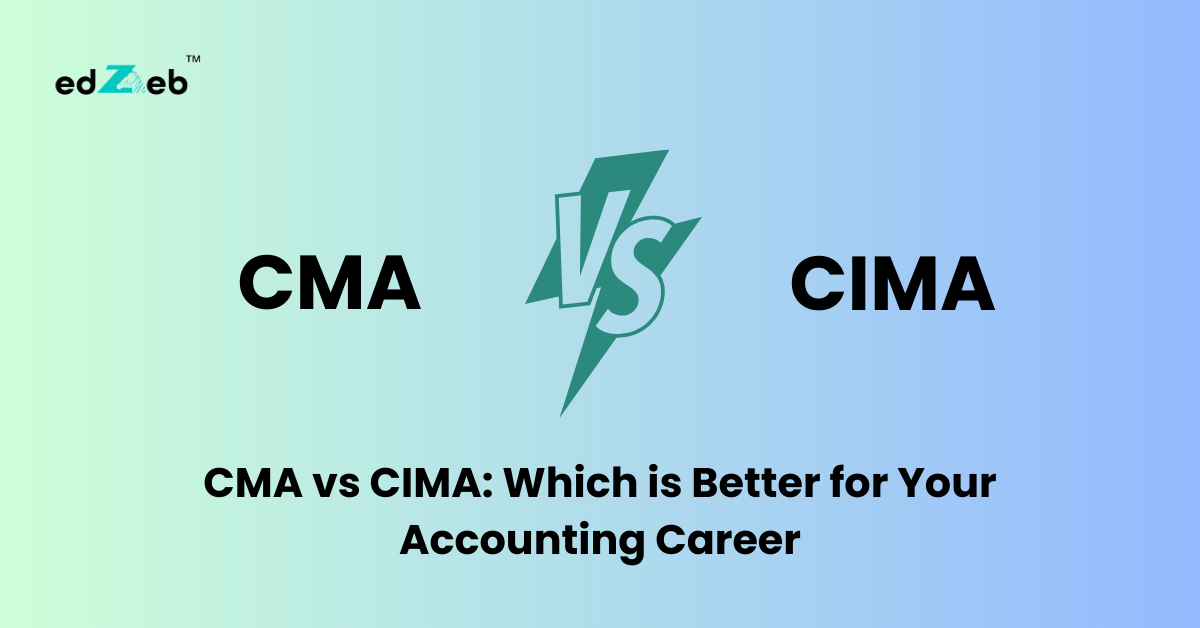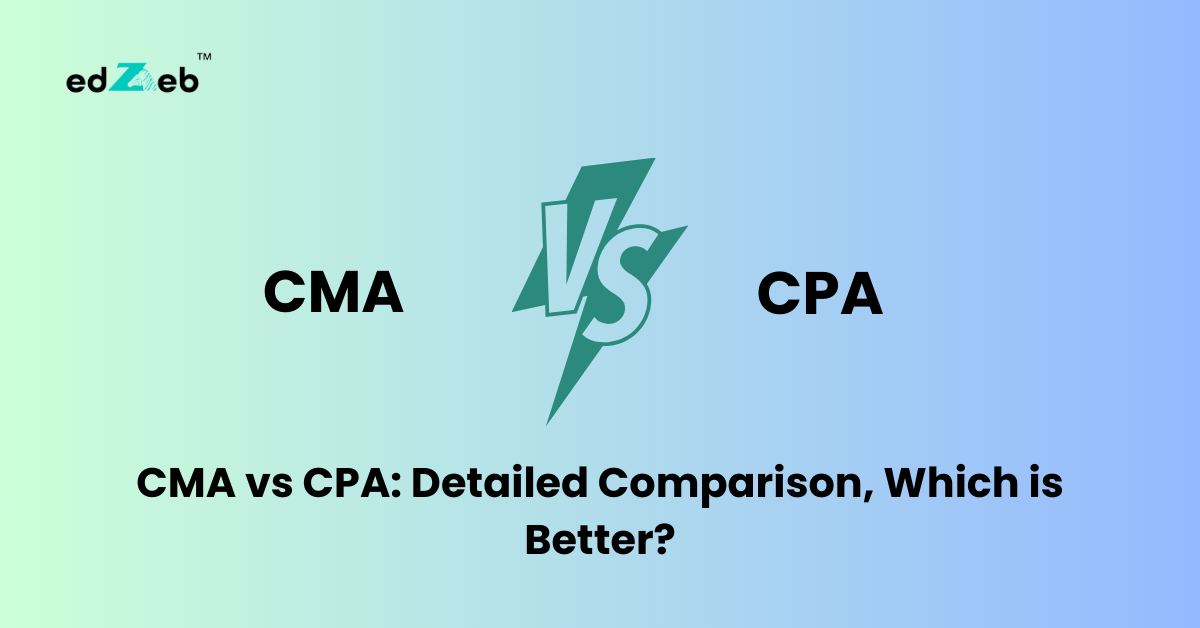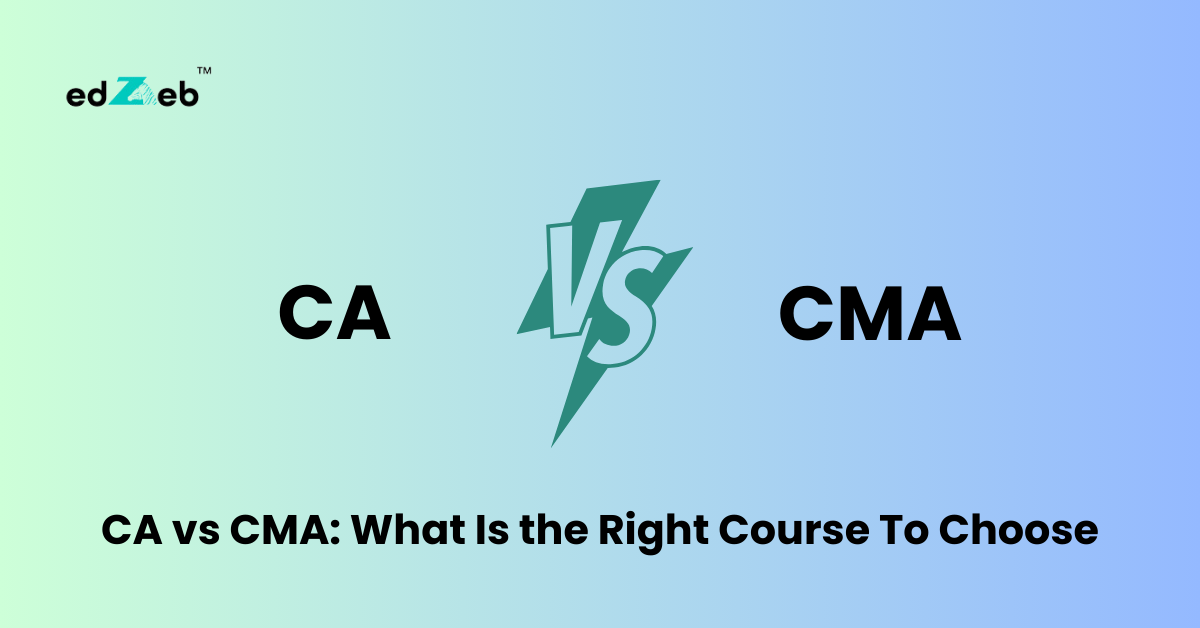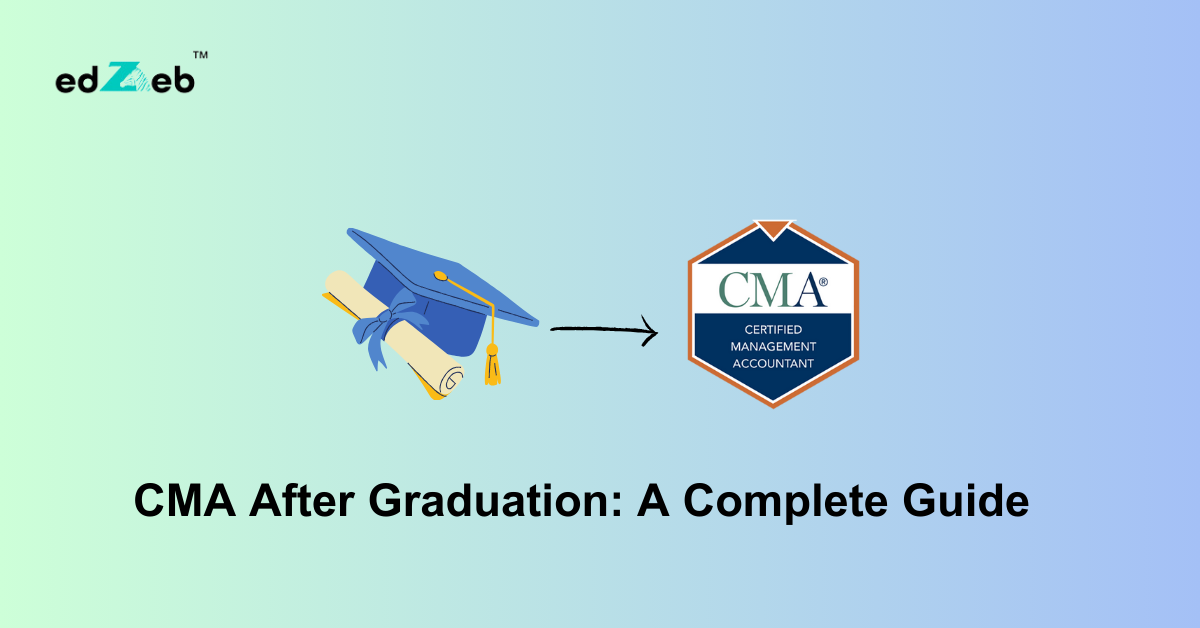
Certifications play a crucial role in shaping the careers of professionals. In an ever-evolving world of accounting and finance, especially when exploring top accounting courses in India, two prominent certifications come up every time in discussions related to certified courses: CMA vs CIMA. While many might think Certified Management Accountants (CMA) and the Chartered Institute of Management Accountants (CIMA) are the same, they are considerably different.
To know more, read the article further and get yourself enlightened on the US CMA vs CIMA facts that differentiate them from each other.
Table of Contents:
CMA vs CIMA: A Detailed Overview
Choosing between CMA and CIMA is quite a challenging task as both of the certifications offer unique advantages and focus on different aspects of accounting and finance. CMA and CIMA open doors to a variety of career opportunities. So to make an informed decision, it is essential to understand these differences.
Here is a brief summary of CMA vs CIMA:
CMA vs CIMA | ||
Feature | CMA (Certified Management Accountant) | CIMA (Chartered Institute of Management Accountants) |
Governing Body | IMA | CIMA |
Focus | USA | UK |
Structure | Two-part exam | Four levels |
Work Experience Requirement | Two years | Three to Four years |
Exam Format | Computer-based multiple-choice and essay questions | Computer-based multiple-choice, case studies, and objective tests |
Recognition | Highly recognized in the US and increasingly globally. | Well-recognized globally, especially in the UK and Commonwealth countries. |
Career Paths | Cost accounting, financial analysis, budgeting, and strategic planning. | Financial management, strategic planning, business partnering, and corporate finance. |
Now let us get into the specific details of CMA US vs CIMA certifications by comparing their benefits, career prospects, and requirements. So that by the end, you will have a clearer understanding of which certification is the best fit for your professional goals.
What is CMA US?
Certified Management Accountants (CMA) is a US-based professional certification. The certification is offered by the Institute of Management Accountants (IMA). It is highly regarded in the field of management accounting. CMA is globally recognized for its focus on financial management and strategic decision-making. The technical skills and the strategic insights offered in the USA CMA course can significantly enhance your career.
Interested in pursuing the CMA US course? Check out the video below for all the important details!
What is CIMA?
Chartered Institute of Management Accountants (CIMA) is a global professional body for management accountants. It is a UK-based certification, which majorly focuses on management accounting, financial management, and strategic business leadership. It is ideal for those who want to enhance their expertise in management accounting and strategic business leadership. This expertise will help professionals seeking advanced job roles in the business and finance sectors.
CMA US vs CIMA Detailed Comparison
Both CMA US and CIMA are highly prestigious certifications but both of them offer varied strengths and professions. It is thus strongly emphasized that understanding their unique features and how they align with your career goals is crucial for making an informed decision. Let us further describe its various aspects like curriculum focus, certification requirements, career opportunities, and global recognition to get into a detailed comparison to help you make a well-informed choice.
1. Educational Requirements
US CMA Requirements
The US CMA program is open for individuals aspiring to a finance career, including graduates, postgraduates, CMA India graduates, commerce graduates, and CA Intermediates.
CIMA Requirements
To enroll in the CIMA program, individuals must have passed 12th, graduation, or post-graduation, especially from a commerce background.
2. Organizing Body
CMA US Organizing Body
IMA is the organizing body for CMA located in the United States.
CIMA Organizing Body
ICMAI is responsible for organizing and conducting CIMA exams.
3. Syllabus
US CMA Syllabus
To get CMA certification, you need to pass all exams, and to do that study the following subjects covered in the CMA syllabus.
- Financial Planning, Performance and Analysis
- Section A: External Financial Reporting Decisions (15% Weightage)
- Section B: Planning, Budgeting and Forecasting (20% Weightage)
- Section C: Performance Management (20% Weightage)
- Section D: Cost Management (15% Weightage)
- Section E: Internal Control (15% Weightage)
- Section F: Technology and Analysis (15% Weightage)
- Strategic Financial Management
- Section A: Financial Statements Analysis (20% Weightage)
- Section B: Corporate Finance (20% Weightage)
- Section C: Decision Analysis (25% Weightage)
- Section D: Risk Management (10% Weightage)
- Section E: Investment Decisions (10% Weightage)
- Section F: Professional Ethics (15% Weightage)
CIMA Syllabus
CIMA certification can be obtained by passing all exams at the Certificate, operational, management, and strategic levels with relevant experience.
Certificate Level
- BA1: Fundamentals of Business Economics
- BA2: Fundamentals of Management Accounting
- BA3: Fundamentals of Financial Accounting
- BA4: Fundamentals of Ethics, Corporate Governance and Business Law
Operational Level
- E1: Managing Finance in a Digital World
- Role of the finance function
- Technology in a digital world
- Data and information in a digital world
- Shape and structure of the finance function
- Finance interacting with the organization
- P1: Management Accounting
- Cost accounting for decision and control
- Budgeting and budgetary control
- Short-term commercial decision-making
- Risk and uncertainty in the short-term
- F1: Financial Reporting
- Regulatory environment of financial reporting
- Financial statements
- Principles of taxation
- Managing cash and working capital
Management Level
- E2: Managing Performance
- Business models and value creation
- Managing people performance
- Managing projects
- P2: Advanced Management Accounting
- Managing the costs of creating value
- Capital investment decision-making
- Managing and controlling the performance of organizational units
- Risk and Control
- F2: Advanced Financial Reporting
- Financing capital projects
- Financial reporting standards
- Group accounts
- Integrated reporting
- Analysing financial statements
Strategic Level
- E3: Strategic Management
- The strategy process
- Analyzing the Organisational Ecosystem
- Generating strategic options
- Making strategic choices
- Strategic control
- Digital strategy
- P3: Risk Management
- Enterprise risk
- Strategic risk
- Internal controls
- Cyber risks
- F3: Financial Strategy
- Financial policy decisions
- Sources of long-term funds
- Financial risks
- Business valuation
4. Duration of Course
US CMA Duration
The US CMA course duration is 12 to 18 months but dedicated study can reduce the CMA US duration to a year or less than that as well.
CIMA Duration
The CIMA duration is 5 to 6 years but some students may take longer than that as well depending on various factors.
5. Course Fee
US CMA Fee
The total US certification CMA fee including the IMA membership cost and exam fees would be approximately $1,325 excluding the cost of coaching and study material. There are certain discounts and scholarships available depending upon certain factors, one of which is whether you are a student or a professional amongst others. These discounts and scholarships can reduce fees significantly for the candidates.
CIMA Fee
CIMA qualification involves a registration fee, exam fees, and each of the three case study exams. Also, a membership application fee after completion is charged. So, the approximate total cost for the CIMA qualification is somewhere around £2,429 to £2,700. In CIMA UK also, alternative routes like FLP (Finance Leadership Program) and Pathway Programs are there which can reduce the cost and/or time significantly for the candidates.
6. Scope
CMA Scope
Professionals with CMA are eligible to work in many areas including costing, budgeting, tax planning, cost reduction, financial restructuring, and variance analysis.
CIMA Scope
CIMA candidates are suitable for management accountants, business analysts, forensic analysts, project managers, and finance controllers job roles because these roles require a combination of strategic thinking and financial expertise.
7. Difficulty
CMA Difficulty
The exam pattern, its structure, and the CMA course duration may add to the level of difficulty as it will test your intellectual limits. The average CMA pass rate is only 45-50% for both sections, so studying hard is necessary.
CIMA Difficulty
It is challenging to crack if you have limited accounting experience and have to manage your personal or professional commitments along with CIMA preparation. Average pass rates in CIMA UK is around 50%.
8. Global Acknowledgment
CMA
Certified Management Accountants is a US-based certification so it is highly valued in the states and over 150 countries including Canada, Australia, North America, and more.
CIMA
CIMA is an international qualification with more than 250000 members and students in around 180 countries.
9. Significance
CMA USA
The CMA is a globally recognized professional certification by the Institute of Management Accountants widely accepted in countries like the US, China, and Canada. It assesses a candidate’s expertise and understanding of management accounting.
CIMA
CIMA is a professional association for accountants in the UK, Ireland, and other Commonwealth countries offering training and qualifications in management accountancy and related subjects. It focuses on strategic management accounting for long-term success and integrates practical work experience, providing ongoing support and training for its members.
10. Exam Format
CMA Exam
The US CMA exam consists of Multiple-Choice Questions (MCQs) and Essay-type questions, with Part 1 and Part 2 being four-hour tests with 100 MCQs and 2 essay questions, with 3 hours for MCQs and 1 hour for Essay-type questions.
CIMA Exam
The CIMA syllabus is split into Certificate Level and three pillars (Enterprise, Performance and Financial) and three more levels (Operational, Management and Strategic) so 13 exams out of all these 16 exams contain objective-type questions, and the rest three are case study exams.
11. CMA vs CIMA Salary
When comparing CMA vs CIMA salary, professionals in both fields enjoy competitive compensation packages. However, the differences in salary often depend on factors like geographic location, industry, experience, and the specific roles they pursue.
CMA Salary
CMA salary package in India is around ₹10 lakhs per year or ₹83,000 per month on average. However, the salary range can also vary from ₹3 lakhs to ₹40 lakhs per year.
CIMA Salary
The CIMA-qualified professionals’ average salary is ₹25 lakhs in India. The salary varies as it can be less for freshers and more for executive-level designations.
CMA vs CIMA: Which is Better
Determine if CMA or CIMA, which is better, completely depends upon factors that align with your career goals and professional objectives. So consider,
Curriculum Focus
Both qualifications have distinct expertise. CMA US professionals are experts in internal financial analysis, budgeting, and decision-making, while CIMA professionals are experts in management accounting, strategic management, risk management, and business leadership.
Career Opportunities
Both qualifications lead to distinct career paths. CMA US holders make careers in management accounting, financial analysis, corporate finance, and other roles that require strong expertise in financial management and internal business strategy. However, CIMA professionals work in business analysis, strategy, risk management, and management consulting.
Exam Structure and Difficulty
Both the programs have rigorous courses to follow but CMA with two objective-type cum essay type exams can be completed within 2 years. CIMA exams are a mix of objective-type questions with case study type questions and can be completed in 1-4 years depending upon the route you choose and what’s your prior qualification like 12th pass out or Graduate or CA/CMA India etc. So, this is what you need to consider before deciding CMA vs CIMA: Which is Better?
Cost and Time Investment
Considering your pockets is also one of the necessary factors along with the time consumed to earn a certification, CIMA vs CMA. It is crucial to consider these factors because balancing your personal commitments with professional responsibilities is key to completing any certification.
Ultimately, thinking about these factors with your career objectives and financial situation will help you choose the right certification that aligns best with your preferences.
Conclusion
Choosing CMA USA vs CIMA is largely dependent on where you see yourself in the future, the skills you wish to develop, and the region you want to work. Ultimately, both certifications provide a pathway to elevate your career, whichever certification you pursue, and your professional profile and open doors to exciting work opportunities in the accounting and finance sectors.
FAQs
Is CMA USA Valid in the UK?
Yes, CMA USA is valid in the UK as it is globally recognized but CIMA is preferred here and in other Commonwealth countries including Ireland.
Can I switch the course from CIMA to CMA USA?
You can switch your course from CIMA to CMA USA as per your will but you must understand that both are different and have different requirements.
Is CMA USA accepted in Canada?
The US CMA, Certified Management Accountant (IMA) is one of the most prestigious qualifications in Management Accounting. It is well-recognized all around the globe, so many job opportunities are available to CMA USA professionals all over the globe including Canada.
Is CMA USA better than CIMA?
See, which is better, CMA or CIMA, you have to decide by considering different factors like the syllabus, exam pattern, exam, and coaching fee, investment of time and effort, etc., and most importantly, choose a certification that aligns with your career goals.
Is CMA USA easier than CIMA?
Easy or not cannot be said but yes it can be completed in less time as compared to CIMA, and CMA is more flexible as compared to the rigor of CIMA.
Who earns more, CMA vs. CIMA salary?
To give you an idea of CMA and CIMA professionals’ earnings, a CMA license holder can earn up to $100,000 p.a. globally, with an average salary of 4 to 6 lakhs p.a. in India, while a CIMA Certified Accountant can earn up to £63,000 p.a. globally, with an average salary of 10 Lakhs per annum in India.
Is CIMA Valid in the USA?
CIMA is a highly sought-after qualification for top decision-making roles in various industries such as construction, manufacturing, medical services, insurance, communication services, and transportation in the USA.







